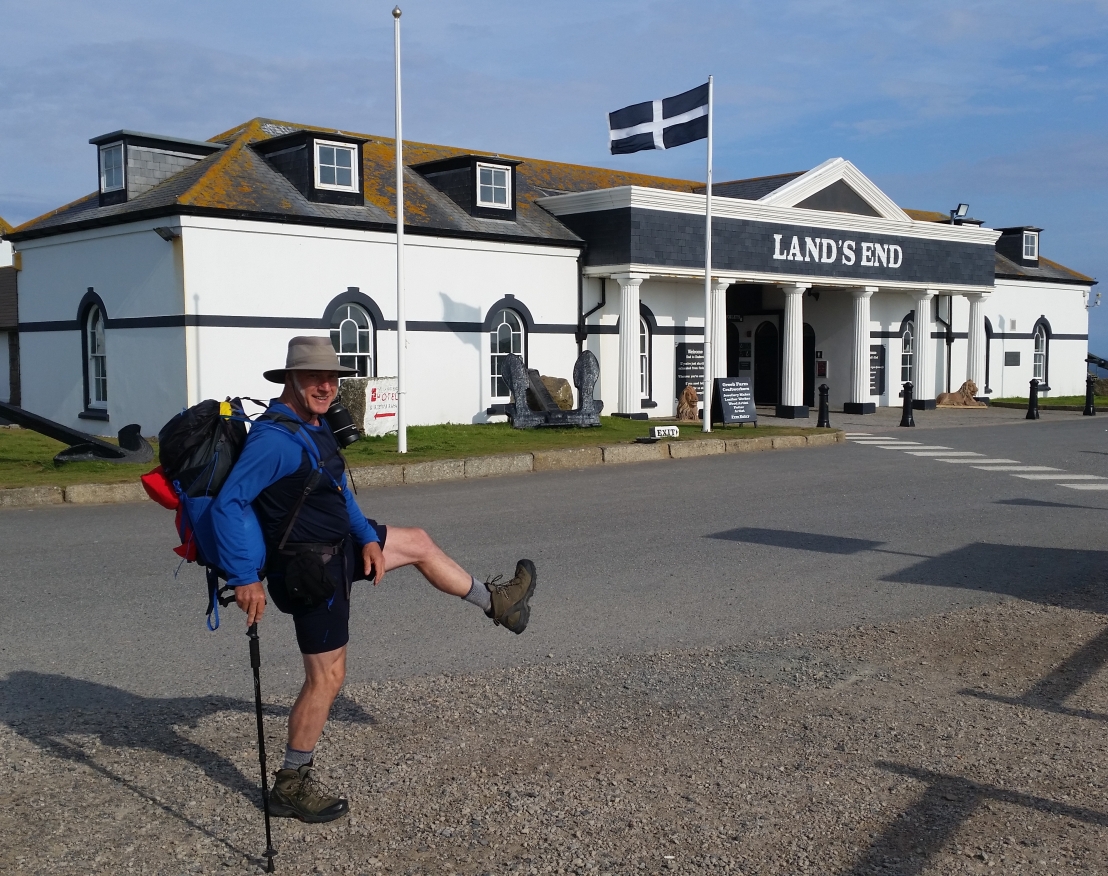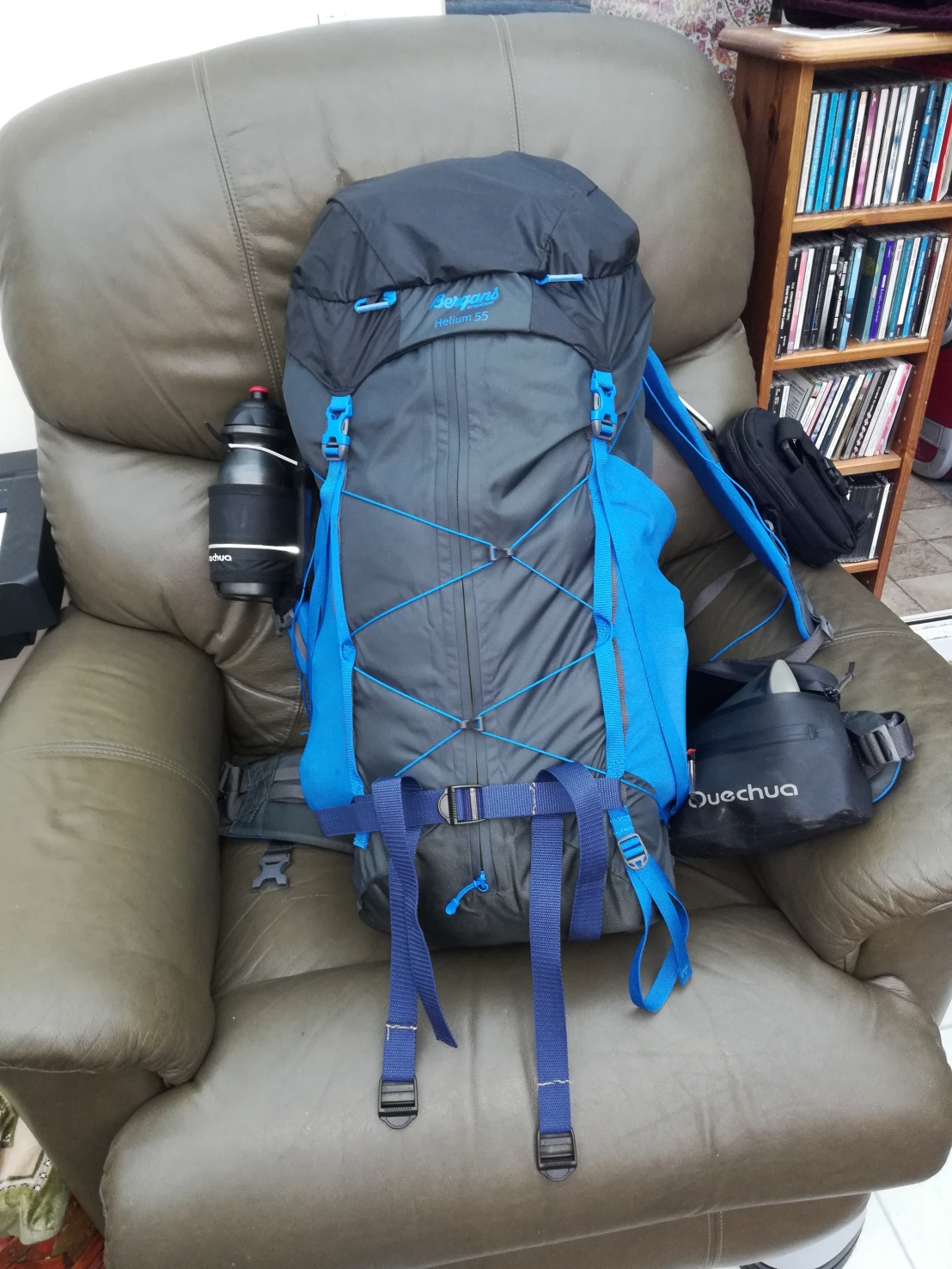
Lessons Learned
So, that’s another long distance walk (LDW) under my belt, this one being 20+ miles (33km) and a full day longer than the Pennine Way (PW), with 7,500 feet (2,330m) more ascent. And I took camping gear this time, increasing my average pack weight by 8lbs (3½kg). Bearing in mind that this was a practice for the greater challenge of walking from Land’s End to John o’ Groats (LEJOG) next year, what lessons have I learned from this one, if any?
Physical stresses
The most important lesson, I think, is that I need to take measures to avoid a repeat of the stress fracture. There are a number of things that’ll help in that regard:
- Incorporate rest days. I deliberately planned no rest day this time just to see if I could hack it, on the principle that you get fitter as you go along. Had it worked out, I would have allowed few, if any, rest days for LEJOG, whereas now I’ll add one for every seven days of walking, approximately.
- Carry less weight. For the SWCP I reduced the weight of non-camping gear so that, once tent, sleeping mat and bag, Jetboil and food had been added, I would only be taking 3½kg over the weight of my PW backpack, which was 10kg. Without camping gear, I’d now hope to reduce the pack weight to around 8kg.
- My fitness level for the SWCP was pretty good, thanks to walks to and from work, using the cross-trainer, doing regular press-ups and practice walks, but I’d originally intended to lose another 5-6lbs (2½kg) in weight, down to 12½ stone (80kg). That’ll be my aim for next year.
- I probably didn’t have enough calcium in my diet; I’m eating more cheese and yoghurt now to help fix the stress fracture, and will try to maintain that level of consumption.
- Take it easy. LEJOG will start off with the northern side of the SWCP, including the notorious ascents around Bude and Lynton, but there’ll be no need for me to walk against the clock or to overtake everyone in sight. Take a deep breath and avoid strains and stresses.
- Consult an orthotics bod. And do exercises specifically aimed at strengthening the anterior tibialis. And maybe get a calf support/compression thingy.
Fluid
On hot days, particularly those with many hills to climb, I was tending to run short of fluid. I’ve already bought a 2 litre Camelbak to replace the 1½ litre one I’ve been using, to complement the 600ml bottle on a Quechua shoulder holster I use for isotonic and the reserve 500ml plastic bottle that I only fill on longer/hotter days. That ought to suffice, particularly if I manage to find the opportunity to buy coffee and/or beer most days. Yes, yes, I know coffee’s a diuretic and therefore not good for re-hydration, but I’m an addict.
Boots
Thorny subject. As I’ll be walking in late spring and summer, lightweight footwear would make sense, but I want good ankle support and I would prefer to keep water out on wet days. I have no problem with wearing stout boots in warm weather, so I’ll probably go with my Altberg Tethera. In the highly unlikely case that next summer proves to be as dry as this one, I might be persuaded to wear the lighter but porous Salomons in the south, as long as Liz can bring out the Altberg a) if the weather changes and b) before I venture up into the boggy North.
Waterproofs
This raises the allied question of how to improve overall impermeability. I only had a day and a half of drizzle on the SWCP and no heavy rain at all, yet my kit still failed. The Mountain Equipment Lhotse jacket was fine, but the idea of wearing quick-drying nylon shorts with gaiters only held up for a couple of hours. And the draw-cord on one of the gaiters snapped. I now have new Rab gaiters to wear under a pair of lightweight Berghaus waterproof trousers in rain, or just with shorts when they only have to contend with long, wet grass. Or is it worth considering, in summer, switching to walking sandals and quick-drying materials and just getting wet?
Ticks
I guess I’ve been fortunate not to have experienced a tick through wearing shorts, but I do carry a tick removal tool. I don’t think I can be persuaded to switch to long trousers in summer – except, perhaps, by a tick. Snag is, I don’t have the patience to check my legs routinely at the end of each day. Maybe that’s a lesson I still have to learn.
Elevation measurement
Next lesson – don’t rely on the Viewranger app for measuring ascent on walks. It’s ok when you plot a route on the Viewranger website, using your pc or laptop, because the amount of ascent is calculated on the basis of countours crossed on OS 1:25000 maps, with a small error margin due to the gradients occurring within the contours. I found that the ascent given on the app at the end of a walk was at least 50% greater than measured on the planned route so, for example, Lulworth to Swanage is around 3,800 feet on the map, but nearer 5,800 feet on your phone when you’ve walked it. This gave me palpitations when I started to think that I’d have to increase the Bude section next year to close on 7,000 feet, until I read about the inaccuracy of gps elevation readings. 4,300 feet over a distance of 15 miles is quite enough, but do-able – especially when I’ve just done 4,000 feet of ascent over 21 miles with a stress fracture! So, don’t panic and trust your original estimate.
Food
Ever since 1976 I’ve taken too much food on walks. In fact my entire life is organised around food and any plans I make must incorporate meals as a sine qua non. Even on the SWCP I carried evening meals and enough muesli and coffee for every night I planned to spend camping, daily rations and cereal bars for each day of the week ahead, supplemented by bread, cheese and apples as I deemed necessary. Were I slightly less anal, I could take just one day’s rations and rely on buying daily replacements, further reducing my pack weight. One of the difficulties with doing that is the lack of reliable information on the Web about local shops in villages, due partly, no doubt to their closure rate. I know there are those who would say ‘man up, take a risk, go hungry for a while’, but I’ve tried that and it doesn’t enhance enjoyment of the walk. I’m sure there’s a happy compromise possible, one that would allow me to take less food but enough to sustain energy and concentration levels.
Rucksack
I won’t want to take the Bergans Helium rucksack again, and not just because 55 litres will be too big. Perhaps the single most irritating thing on the SWCP and my practice walks was the squeaking noise made by the fabric stitched around the rucksack’s metal frame as it slid up and down. I tried oil and silicone spray, but it made no difference. I’ll either revert to the 45 litre Highlander, which works quite well for me, or, if that’s too big, check out something like the Osprey Exos 38 or Stratos 36. Or perhaps the Lowe Alpine AirZone Pro 35-45 for its flexibility. I have to take account of the fact that I want to camp on four consecutive nights at the start of the PW, after which I’ll leave camping and cooking gear to be collected; that means I’ll either need a rucksack with compression straps that can expand to accommodate the extra gear, or have straps to enable it to be attached above and below.
Walking Stick
I have a love-hate relationship with sticks. I will NOT use poles under any circumstances, and I always end up losing sticks, which I find pretty annoying anyway. Having said that, they are a help on steep, stepped descents, on boggy ground as a depth gauge and for poking the noses of yappy dogs. I’ll probably take and lose one again. Is it worth buying an expensive Leki stick to encourage me to look after it better?
Hankies
I lost so many hankies on the SWCP that a walking forum correspondent queried how I’d achieve an 8kg pack weight when I’ll need to allow 2kg for hankies! Maybe I’ll just switch pockets and have one protruding from my breast pocket like Poirot, where at least I should be able to keep an eye on it!
Accommodation
The experience at Newton Ferrers, where the farm advertising a campsite on the Web had decided to stop providing space for tourers and campers and was instead erecting chalets, has taught me that, even if I’m not booking ahead, I still need to confirm availability. I’ll start booking b&bs before Christmas for particular pinch-points where there are few, if any, alternatives available.
In conclusion, then, I’m feeling upbeat about my ability to get started on LEJOG and, once I get started, I’ll be pretty determined to complete it. I just need to fix my leg in the same way I fixed my knees prior to doing the PW. Wish me luck!
